Civil Technology: Woodworking Grade 12 Memorandum - NSC Past Papers And Memos September 2020 Preparatory Examinations
Share via Whatsapp Join our WhatsApp Group Join our Telegram GroupMEMORANDUM
QUESTION 1: SAFETY AND MATERIALS (GENERIC)
1.1
1.1.1 2 (1)
1.1.2 228 mm (1)
1.1.3 900 mm (1)
1.1.4 150 mm (1)
1.1.5 Non-slippery layer (1)
1.2 Similar answer:
- Prevents horizontal movement between the platform and structure (1)
1.3 Identify THREE of the following requirements that are applicable to the supplier of hazardous chemical substances:
1.3.1 First-aid measures must be indicated
1.3.4 Fire-fighting measures must be indicated
1.3.6 Storage instructions must be indicated (3 x 1) (3)
1.4 Minimum = 30⁰ (1) and maximum = 50⁰ (1) (2)
1.5 Similar answer:
- Aluminium conducts electricity (1) and workers who use a ladder could be shocked (1) (2)
1.6 Describe the difference between the surface finish of a water-based paint and an oil-based paint:
- Water-based – provide an elastic, flexible finish (1) Oil-based – provide a hard, durable finish (1) (2)
1.7 Any THREE advantages of the curing of concrete:
- Increases strength
- Decreases permeability
- Improves durability
- Reduces cracks
- Makes concrete more watertight
- Provides volume stability
- Concrete can carry more weight (3 x 1) (3)
1.8 Briefly describe the powder coating process:
- Plastic finish in powder form (1) is applied through a compressed air spray-gun (1) (2)
[20]
QUESTION 2: GRAPHICS, JOINING AND EQUIPMENT (GENERIC)
2.1 Answer the following questions with regard to the site plan on ANSWER SHEET A:
2.1.1 See ANSWER SHEET A (10)
2.1.2 See ANSWER SHEET A (6)
2.2
2.2.1 Undisturbed earth ![]() (2)
(2)
2.2.2 Plaster ![]() (2)
(2)
2.2.3 Ramp with a slope of 1 : 5 1:5  (2)
(2)
2.2.4 Electrical meter W  (2)
(2)
2.2.5 Sink unit – double  (2)
(2)
2.3
2.3.1 ![]() Unfinished wood (1)
Unfinished wood (1)
2.3.2 ![]() Two-way switch (1)
Two-way switch (1)
2.4 When driven into place (1) it cannot be turned (1) (2)
2.5 Prevents backing off OR it acts as a lock nut (1)
2.6 18 mm (1)
2.7
2.7.1 1,35 m (1)
2.7.2 1,412 – 1,285 = 0,127 x 100 = 12,7m (0,1m leeway allowed) (3)
2.7.3 Minimum = 30 m (1) and maximum = 200 m (1) (2)
2.8 It can affect the measuring function of the tool. (1)
2.9 Batteries must be removed. (1)
[40]
TOTAL SECTION A: 60
QUESTION 3: CASEMENTS, CUPBOARDS, WALL-PANELLING AND QUANTITIES (SPECIFIC)
3.1 3.1.1 16 mm (1)
3.1.2 Stuck mould (1)
3.1.3 Rebate (1)
3.2
3.2.1 Drip groove (1)
3.2.2 Transom
- Bottom rail of fanlight 60 mm x 44 mm Putty
- Ovol moulding
- Windowpane/glass (3 x 1) (3)
3.2.3 Enhances the appearance and can open separately to allow ventilation (1)
3.3 ANSWER SHEET B (5)
3.4
3.4.1
- Top shelf/storage space
- Hanging space
- Shelving
- Drawer unit (4)
3.4.2
- Melamine is waterproof
- Easy to clean
- Durable
- Smooth finish
- Improves appearance (Any 1) (1)
3.4.3
- E = Front rail G = Side of cabinet
- F = Handrail H = Kick plate (4)
3.5 Fanlight (1)
3.6
3.6.1
- A = Cornice
- B = Horizontal rough grounds
- C = Quadrant mould (3)
3.6.2
- Provide storage space
- Improves/enhances the aesthetic appeal of the room
- Looks expensive (2)
3.7 A casement window can be defined as a window assembly that has at least one casement or vertically hinged sash (frame that holds the glass) (2)
[30]
QUESTION 4: ROOFS, CEILINGS, TOOLS AND EQUIPMENT, AND MATERIALS (SPECIFIC)
4.1
4.1.1 A = Router B = Radial arm saw (2)
4.1.2
- Lubricate and adjust according to the manufacturer’s instructions
- Clean the saw after use
- Repair or replace damaged electrical cords
- Use machinery only for the intended purpose
- Keep ventilation holes open and clean (2)
4.1.3
- Always wear safety goggles
- Use both hands to operate the machine
- Stand firmly and comfortably
- Wear a dusk mask when using the router
- The workpiece must be gripped firmly before starting the moulding (2)
4.2
- Gypsum ceiling board
- Cover strips
- Trapdoor panel
- Tie beam (2)
4.3
- Sand the wood with different grades of sandpaper
- Sand until it is smooth and free from scratches
- Remove all dust (3)
4.4 Hurricane clips:
- Securing purlins to rafter (roof truss)
- Securing trusses to wall plates
- Ideally used at eaves overhangs
- Where trusses cross each other or where truss members cross each other or meet at 90°
- To fix opposite faces of roof members
Storm clips: Securing roof tiles to the battens (2)
4.5
- Strength
- Density (2)
4.6
- King post positioned in the middle of the roof truss
- Brandering is nailed to the tie beam and to existing brandering
- Roof sheeting to cover the roof (3)
4.7
- Always wear safety goggles
- Wear a dusk mask when using the belt sander
- Inspect the power cord regularly for damage
- Avoid carrying the machine by the cord (2)
4.8
4.8.1
- A. Tie beam
- B. Brandering
- C. Brandering
- D. Trapdoor
- E. Ceiling board (5)
4.8.2 Cover strips keep the panels in place (2)
4.8.3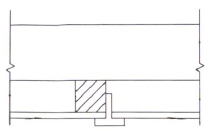
Sectional view showing a metal T-strip (3)
4.9
4.9.1
- A. Hipped end
- B. Purlin
- C. Ridge
- D. Valley rafter
- E. Overhang
- F. Gable end (6)
4.9.2 75 mm x 50 mm (2)
4.10
- Must be able to withstand natural elements like rain, wind and corrosion
- Must look expensive and must be able to improve the appearance of the building
- Must be able to withstand fire
- To insulate against heat and cold (2)
[40]
QUESTION 5: CENTRING, FORMWORK,SHORING AND GRAPHICS AS MEANS OF COMMUNICATION (SPECIFIC)
5.1
- Plastic
- Metal sheeting
- Hardboard
- Fibreglass (1)
5.2 ANSWER SHEET C (6)
5.3
5.3.1 Double flying shore: used to provide temporary support to two parallel walls that are located between 9 metres and 15 metres apart where one or both walls show signs of failure (1)
5.3.2 Dead shore:
- Support structures
- Carry the dead weight of the structure above them, for example walls and floors
- New openings for existing walls and doors underpinning, is needed during restoration of the wall (1)
5.4
5.4.1 Steel dogs: nails used to secure the joint between prop and needle (1)
5.4.1 Sole plate: made of timber to spread the weight transferred by the props over a wider area (1)
5.4.3 Props or struts: placed vertically on top of each other on the different floors to strengthen or brace the floors and ceilings (1)
5.5
5.5.1
- A – Concrete/floor slab
- B – Brace/strut
- C – Prop
- D – Sole plate (4)
5.5.2
- To support the formwork
- Keep the different formwork components sturdy and fixed
- Facilitate the raising or lowering of the formwork to the required height
- For levelling the formwork
- Ease the striking of formwork after the concrete has cured (4)
5.6
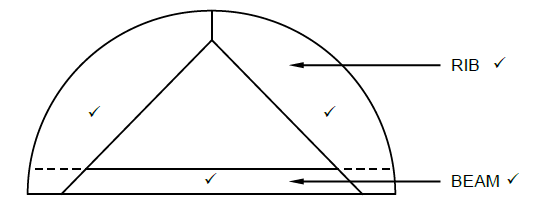
| ASSESSMENT CRITERIA | MARK |
| Beam | 1 |
| Ribs | 2 |
| Two labels | 2 |
| Correctness of drawing | 1 |
| TOTAL: | 6 |
(6)
5.7
5.7.1
- To lower
- To raise the centre (2)
5.7.2
- Table saw
- Bandsaw
- Jigsaw
- Portable circular saw
- Circular saw (Any 2) (2)
[30]
QUESTION 6: SUSPENDED FLOORS, STAIRCASES, IRONMONGERY, DOORS AND JOINING (SPECIFIC)
6.1
- A. Place to rest
- B. For safety reasons in case of an accident
- C. Change of direction (2)
6.2
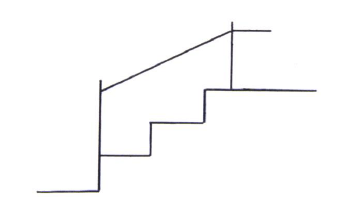
(5)
6.3
- On a cupboard door
- On a drawer (2)
6.4 Night latch (1)
6.5
Correctness
| ASSESSMENT CRITERIA | MARK |
| Muntin | 1 |
| Raised panels | 2 |
| Space for expansion and shrinkage | 1 |
| Hatching | 1 |
| Correctness of drawing | 1 |
| TOTAL | 6 |
(6)
6.6 The opening allows for shrinkage and expansion of wood (1)
6.7
6.7.1 A: Brace B: Tongue and groove panels C: Stile (3)
6.7.2 To prevent sagging (1)
6.7.3 Gives a neater appearance at the outside of the frame members (1)
6.8
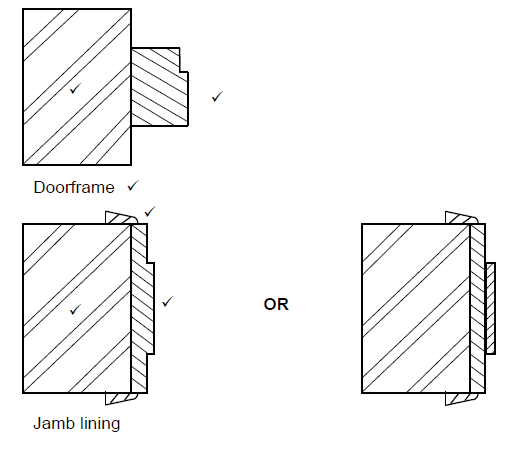
| ASSESSMENT CRITERIA | MARK |
| Walls | 2 |
| Frame profile of door | 1 |
| Jamb lining profile | 1 |
| Title | 1 |
| Architraves | 1 |
| TOTAL: | 6 |
6.9
6.9.1
- A = 220mm wall
- E = Floor joist
- B = 12 mm plaster F = Wall plate/bearers
- C = Skirting G = Damp-proof course (DPC)
- D = Floorboard H = Foundation (8)
6.9.2 To cover the gaps between the flooring and the wall (1)
6.9.3
- Span of the floor
- The centre-to-spacing between the floor joist; and
- The grade of timber of the floor (3)
[40]
TOTAL: 200
ANSWER SHEET A
2.1 Answer the following questions with regard to the site plan on ANSWER SHEET A:
2.1.1 Any TEN particulars that are not shown according to the checklist:
- Plot no. 31 is not shown
- Plot depth measurement is not shown
- Street name is not shown
- Branch sewage at S is not shown
- Connecting manhole (1,5 m inside plot boundary) is not shown
- Measurements of southern building boundary are not shown
- Structure measurements are not shown
- RE (rodding eye) symbol is not shown
- IE symbols are not shown
- VP and symbol are not shown at WC
- Entrance to plot is not shown
- No datum level is shown (10)
2.1.2 Identify SIX particulars that are shown incorrectly on the site plan:
- Construction is over the building boundary on the west side
- North arrow must be right-hand side, at the bottom of the page
- Scale is shown incorrectly
- Corner of branch sewage at WB incorrect
- RE and symbol missing at the change of direction in sewage line
- House depth measurements are not shown (6)
ANSWER SHEET B
QUESTION 3.3
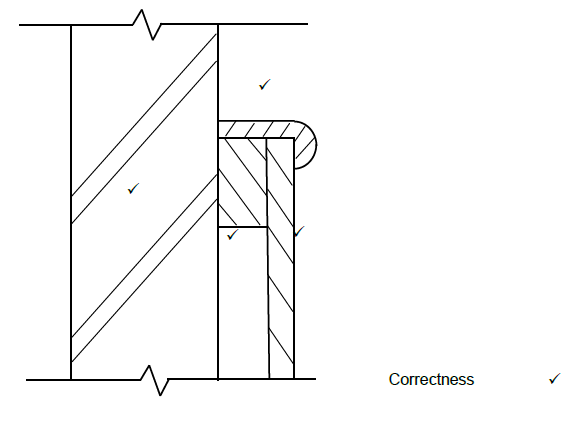
| ASSESSMENT CRITERIA | MARK |
| Wall | 1 |
| Capping | 1 |
| Rough ground | 1 |
| Tongue and groove board | 1 |
| Correctness of drawing | 1 |
| TOTAL: | 6 |
ANSWER SHEET C
QUESTION 5.2
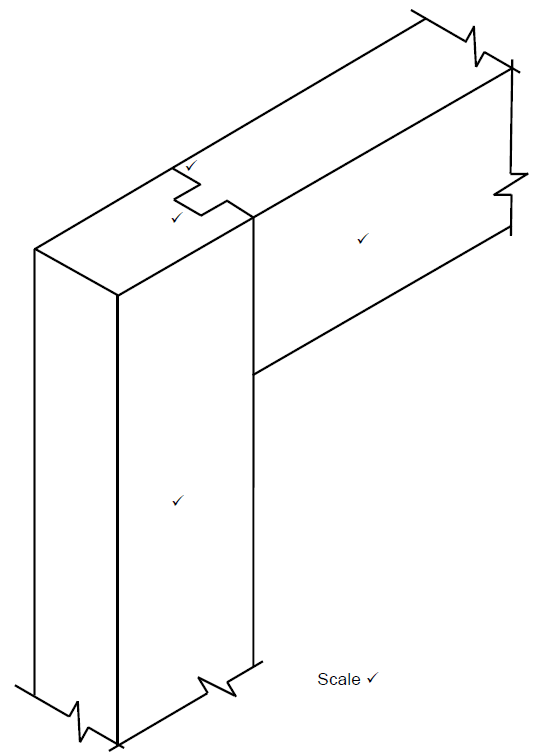
| ASSESSMENT CRITERIA | MARK |
| Stile | 1 |
| Top rail | 1 |
| Mortise | 1 |
| Haunch | 2 |
| Application of scale | 1 |
| TOTAL: | 6 |